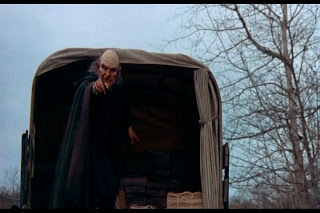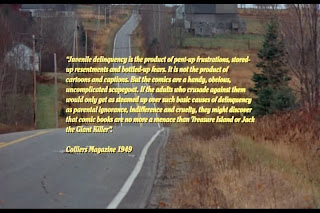Horror Anthology #2: CREEPSHOW 2 (Michael Gornick, 1987)

Sharing much more in common with Laurel Entertainment’s then-ongoing “Tales from the Darkside” syndicated series than the innovative original, CREEPSHOW II, the follow-up to George A. Romero and Stephen King’s ode to the EC Comics of the 1950s, is a streamlined production with a trio of unnerving tales in place of the first film’s more generous five. Made on the cheap at New World Pictures, Romero punted off the directorial reins to his former cinematographer, Michael Gornick, who dims down the heightened phantasmagoria/comic book lighting compositions from the first film (the commentary track reveals that it was more due to budgetary constraints than any kind of stylistic overhaul on the director’s part). King receives story credit, while Romero adapts the tales into workable screenplay form (the most altered being “The Raft”, originally published in “Twilight Zone Magazine”, and later collected in “Skeleton Crew”, as Romero adds a last-minute, trailer-moment jolt that’s nowhere to be found in the King short story).

Nearly everybody who has seen the film seems to only recall “The Raft” with any clarity, probably in part to its involving the perennial 80s favourite of pot-smoking, promiscuous young adults looking for a good time (and this time, vs. an amorphous, deadly “oil rig”), but “The Hitchhiker” (with obligatory Stephen King cameo as a backwoods trucker) is arguably just as memorable and remains a potent little shocker (it's also director Gornick’s favourite).
This tale features Lois Chiles (Dr. Holly Goodhead of MOONRAKER infamy, filling in as a last minute replacement for Barbara Eden, who had to leave the production in order to be with her ailing mother) as a well-to-do businesswoman racing home to her husband from the willing arms of her $100 a night gigolo. Sleekly sliding into her Mercedes, she begins to jam it home in a hurry, but gets preoccupied in a prolonged hit-and-run with a hitchhiking black man in a yellow raincoat -- and his progressively mangled, undead body that haunts her every subsequent step of the way home. But don’t let the simplistic casting fool you, as this combat between posh upper-class Chiles and her tormenting working class zombie (Tom Wright) really has nothing to say in the interest of racial politics save for the most innocuous, on-the-surface sort. Still, it’s a prolonged chiller that goes a long way to express how the psyche can work in overtime to deal with and justify blunt traumas, and how immediate and fatal accidents pierce through and plague the morality of even the blackest of hearts.
The less said about “Old Chief Wood’nhead” the better, especially when considering the laughable lines given to the long, silky haired Holt McCallany (“This hair’ll get me paid and laid!”); McCallany portrays one of three small-town hoodlums paving their way to Hollywood by robbing an old-fashioned mom and pop general store (run by George Kennedy and Dorothy Lamour, in her final screen appearance). The practical make-up FX (by Howard Berger, Greg Nicotero, and Ed French) of the rampaging, revenging Wooden Indian are solid and intimidating, and the only elements that prevent the film from drowning after the initial staid set-up that goes on and on to indicate how Kennedy and Lamour are pillars to this blustery Arizona community.
The framework that ties it all together is an all-too-brief appearance by Tom Savini as The Creep, followed by some economical animation of a bullied blonde-haired boy who extracts comeuppance through the classified ads in the fictional “Creepshow” comic. Gornick’s preliminary framework, which was shot down during pre-production, promised much, much more: stock footage and audio clips of the senate hearings between EC Comics publisher/co-editor Bill Gaines, contrasted alongside those of Dr. Fredric Wertham, the unreasonable and puritanical oppressing mind behind “Seduction of the Innocent”, the book that attempted to point out the devious underpinnings and thematic content inherent in just about any comic book. All that remains is a quote, buried in the closing credits:
Labels: Creepshow 2, George A. Romero, Michael Gornick







0 Comments:
Post a Comment
<< Home